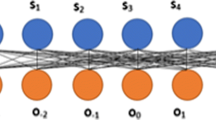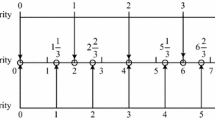Abstract
The concept of dual hesitant fuzzy set arising from hesitant fuzzy set is generalized by including a function reflecting the decision maker’s fuzziness about the non-membership degree of the information provided. This paper studies some dual hesitant fuzzy information aggregation operators for aggregating dual hesitant fuzzy elements, such as dual hesitant fuzzy Heronian mean operator and dual hesitant fuzzy geometric Heronian mean operator. The research resulting dual hesitant fuzzy information aggregation operators finds an important role in group decision making (GDM) applications. It can fusion the experts’ opinion to the comprehensive ones and based on which an optimal decision making scheme can be determined. The properties of the proposed operators are studied and the application on GDM are investigated. The effectiveness of the GDM method is demonstrated on the case study about supplier selection.














Similar content being viewed by others
References
Atanassov KT (1986) Intuitionistic fuzzy sets. Fuzzy Sets Syst 20(1):87–96
Zadeh LA (1965) Fuzzy sets. Inf Control 8(3):338–353
Zhang Z, Wang M, Hu Y, Yang J, Ye Y, Li Y (2013) A dynamic interval-valued intuitionistic fuzzy sets applied to pattern recognition. Math Probl Eng 2013(408012):16
Papakostas GA, Hatzimichailidis AG, Kaburlasos VG (2013) Distance and similarity measures between intuitionistic fuzzy sets: a comparative analysis from a pattern recognition point of view. Pattern Recognit Lett 34(14):1609–1622
Boran FE, Akay D (2014) A biparametric similarity measure on intuitionistic fuzzy sets with applications to pattern recognition. Inf Sci 255:45–57
Wei GW, Zhao XF (2012) Some induced correlated aggregating operators with intuitionistic fuzzy information and their application to multiple attribute group decision making. Expert Syst Appl 39(2):2026–2034
Tao F, Zhao D, Zhang L (2010) Resource service optimal-selection based on intuitionistic fuzzy set and non-functionality QoS in manufacturing grid system. Knowl Inf Syst 25(1):185–208
Wei GW, Wang HJ, Lin R (2011) Application of correlation coefficient to interval-valued intuitionistic fuzzy multiple attribute decision-making with incomplete weight information. Knowl Inf Syst 26(2):337–349
Tan CQ, Chen XH (2010) Intuitionistic fuzzy Choquet integral operator for multi-criteria decision making. Expert Syst Appl 37(1):149–157
He YD, Chen HY, Zhou LG, Han B, Zhao Q, Liu J (2014) Generalized intuitionistic fuzzy geometric interaction operators and their application to decision making. Expert Syst Appl 41(5):2484–2495
Torra V, Narukawa Y (2009). On hesitant fuzzy sets and decision. In: IEEE international conference on fuzzy systems, 2009. FUZZ-IEEE 2009, pp 1378–1382
Dubois DJ (1980) Fuzzy sets and systems: theory and applications (Vol. 144). Academic press, New York
Miyamoto S (2005) Remarks on basics of fuzzy sets and fuzzy multisets. Fuzzy Sets Syst 156(3):427–431
Yager RR (1986) On the theory of bags. Int J Gen Syst 13(1):23–37
Miyamoto S. (2000). Multisets and fuzzy multisets. In Soft computing and human-centered machines (pp. 9-33). Springer, Tokyo
Torra V (2010) Hesitant fuzzy sets. Int J Intell Syst 25(6):529–539
Xu ZS, Xia MM (2011) On distance and correlation measures of hesitant fuzzy information. Int J Intell Syst 26(5):410–425
Xia MM, Xu ZS (2011) Hesitant fuzzy information aggregation in decision making. Int J Approx Reason 52(3):395–407
Xia MM, Xu ZS, Chen N (2013) Some hesitant fuzzy aggregation operators with their application in group decision making. Group Decis Negot 22(2):259–279
Zhu B, Xu ZS, Xia MM (2012) Hesitant fuzzy geometric Bonferroni means. Inf Sci 205:72–85
Zhu B, Xu ZS (2014) Consistency measures for hesitant fuzzy linguistic preference relations. IEEE Trans Fuzzy Syst 22(1):35–45
Zhu B, Xu ZS (2013) Hesitant fuzzy Bonferroni means for multi-criteria decision making. J Oper Res Soc 64(12):1831–1840
Zhu B, Xu ZS, Xia MM (2012) Dual hesitant fuzzy sets. J Appl Math. 879629:13. doi:10.1155/2012/879629
Chen Y, Peng X, Guan G, Jiang H (2014) Approaches to multiple attribute decision making based on the correlation coefficient with dual hesitant fuzzy information. J Intell Fuzzy Syst 26(5):2547–2556
Zhu B, Xu ZS (2014) Some results for dual hesitant fuzzy sets. J Intell Fuzzy Syst 26:1657–1668
Farhadinia B (2014) Correlation for dual hesitant fuzzy sets and dual interval-valued hesitant fuzzy sets. Int J Intell Syst 29(2):184–205
Wang L, Ni M, Zhu L (2013) Correlation measures of dual hesitant fuzzy sets. J Appl Math 593739:12
Ye J (2014) Correlation coefficient of dual hesitant fuzzy sets and its application to multiple attribute decision making. Appl Math Model 38(2):659–666
Wang H, Zhao XF, Wei GW (2014) Dual hesitant fuzzy aggregation operators in multiple attribute decision making. J Intell Fuzzy Syst 26(5):2281–2290
Beliakov G, Pradera A, Calvo T (2007) Aggregation functions: a guide for practitioners. Springer, Berlin
Yu DJ (2013) Intuitionistic fuzzy geometric Heronian mean aggregation operators. Appl Soft Comput 13(2):1235–1246
Yu DJ, Wu YY (2012) Interval-valued intuitionistic fuzzy Heronian mean operators and their application in multi-criteria decision making. Afr J Bus Manag 6(11):4158–4168
Bonferroni C (1950) Sulle medie multiple di potenze. Bollettino dell’Unione Matematica Italiana 5(3–4):267–270
Yager RR (2009) On generalized Bonferroni mean operators for multi-criteria aggregation. Int J Approx Reaso 50(8):1279–1286
Xu ZS, Yager RR (2011) Intuitionistic fuzzy Bonferroni means. IEEE Trans Syst Man Cybern B Cybern 41(2):568–578
Xia MM, Xu ZS, Zhu B (2012) Generalized intuitionistic fuzzy Bonferroni means. Int J Intell Syst 27(1):23–47
Xia M, Xu Z, Zhu B (2013) Geometric Bonferroni means with their application in multi-criteria decision making. Knowl Based Syst 40:88–100
Gau WL, Buehrer DJ (1993) Vague sets. IEEE Trans Syst Man Cybern 23(2):610–614
Zadeh LA (1975) The concept of a linguistic variable and its application to approximate reasoning—I. Inf Sci 8(3):199–249
Atanassov KT, Gargov G (1989) Interval valued intuitionistic fuzzy sets. Fuzzy Sets Syst 31(3):343–349
Chen SJ, Chen SM (2005) Fuzzy information retrieval based on geometric-mean averaging operators. Comput Math Appl 49(7):1213–1231
Xu ZS, Yager RR (2006) Some geometric aggregation operators based on intuitionistic fuzzy sets. Int J Gen Syst 35(4):417–433
Wang WZ, Liu XW (2011) Intuitionistic fuzzy geometric aggregation operators based on Einstein operations. Int J Intell Syst 26(11):1049–1075
Yu DJ (2012) Group decision making based on generalized intuitionistic fuzzy prioritized geometric operator. Int J Intell Syst 27(7):635–661
Zhang ZM (2013) Generalized Atanassov’s intuitionistic fuzzy power geometric operators and their application to multiple attribute group decision making. Inf Fus 14(4):460–486
Wang WZ, Liu XW (2013) The multi-attribute decision making method based on interval-valued intuitionistic fuzzy Einstein hybrid weighted geometric operator. Comput Math Appl 66(10):1845–1856
Yu DJ (2013) Decision making based on generalized geometric operator under interval-valued intuitionistic fuzzy environment. J Intell Fuzzy Syst 25(2):471–480
Wang XZ, Dong CR (2009) Improving generalization of fuzzy IF–THEN rules by maximizing fuzzy entropy. IEEE Trans Fuzzy Syst 17(3):556–567
Wang XZ, Dong LC, Yan JH (2012) Maximum ambiguity-based sample selection in fuzzy decision tree induction. IEEE Trans Knowl Data Eng 24(8):1491–1505
Wang XZ, Xing HJ, Li Y, Hua Q, Dong CR, Pedrycz WA (2014) Study on relationship between generalization abilities and fuzziness of base classifiers in ensemble learning. IEEE Trans Fuzzy Syst. doi:10.1109/TFUZZ.2014.2371479
Chu TC, Varma R (2012) Evaluating suppliers via a multiple levels multiple criteria decision making method under fuzzy environment. Comput Ind Eng 62(2):653–660
Dalalah D, Hayajneh M, Batieha F (2011) A fuzzy multi-criteria decision making model for supplier selection. Expert Syst Appl 38(7):8384–8391
Boran FE, Genç S, Kurt M, Akay D (2009) A multi-criteria intuitionistic fuzzy group decision making for supplier selection with TOPSIS method. Expert Syst Appl 36(8):11363–11368
Acknowledgments
The authors wish to thank the anonymous reviewers and Editor-in-Chief for their constructive comments on this study. This work has been supported by China National Natural Science Foundation (No. 71301142), Zhejiang Science & Technology Plan of China (2015C33024), Zhejiang Provincial Natural Science Foundation of China (No. LQ13G010004), Project Funded by China Postdoctoral Science Foundation (No. 2014M550353) and the National Education Information Technology Research (No. 146242069).
Author information
Authors and Affiliations
Corresponding author
Rights and permissions
About this article
Cite this article
Yu, D., Li, DF. & Merigó, J.M. Dual hesitant fuzzy group decision making method and its application to supplier selection. Int. J. Mach. Learn. & Cyber. 7, 819–831 (2016). https://doi.org/10.1007/s13042-015-0400-3
Received:
Accepted:
Published:
Issue Date:
DOI: https://doi.org/10.1007/s13042-015-0400-3




